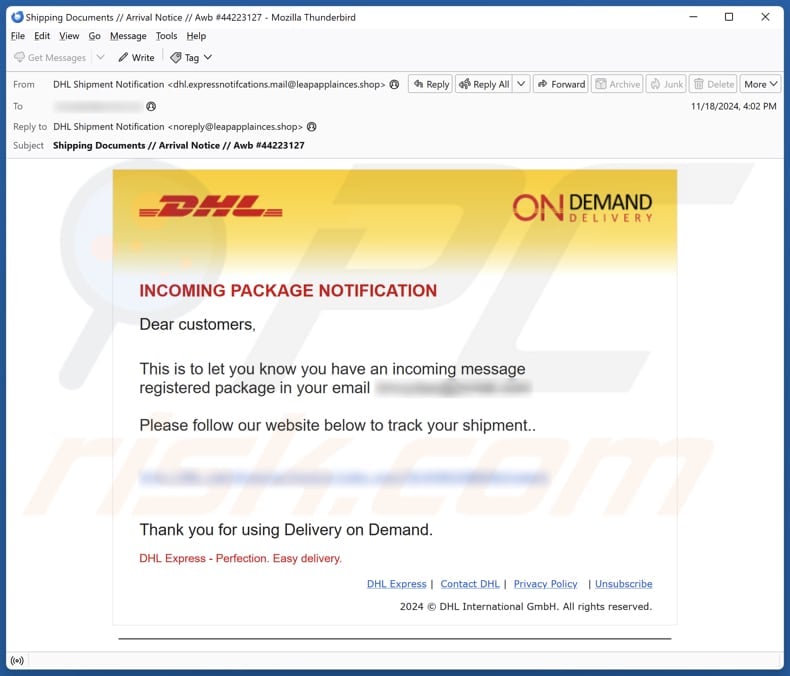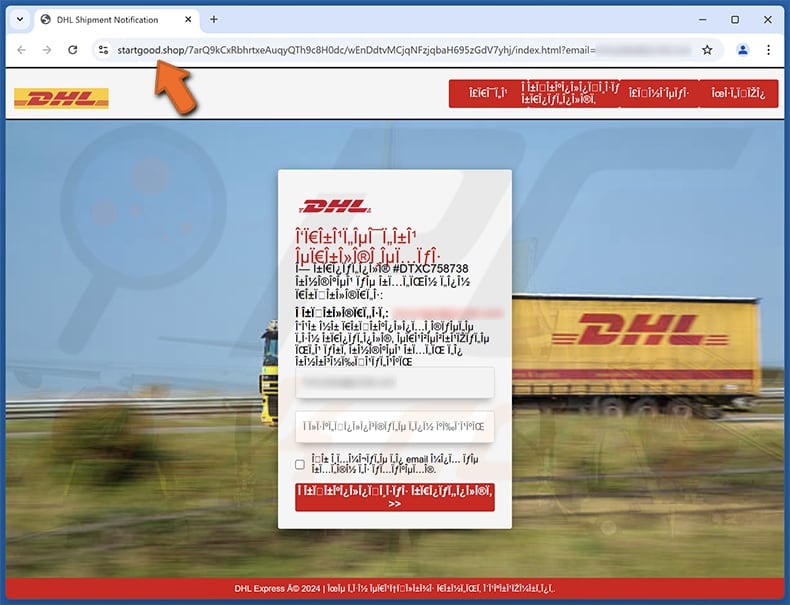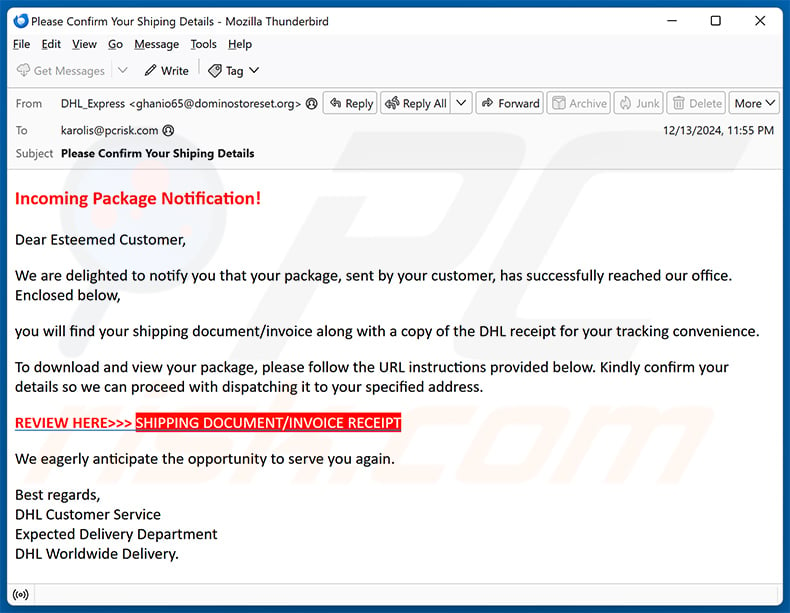How to spot scams like "DHL - INCOMING PACKAGE NOTIFICATION"
Phishing/ScamAlso Known As: DHL - INCOMING PACKAGE NOTIFICATION phishing email
Get free scan and check if your device is infected.
Remove it nowTo use full-featured product, you have to purchase a license for Combo Cleaner. Seven days free trial available. Combo Cleaner is owned and operated by RCS LT, the parent company of PCRisk.com.
What is "DHL - INCOMING PACKAGE NOTIFICATION"?
Our analysis confirms that the email is a phishing attempt, pretending to be a notification from DHL (a legitimate logistics company). Its goal is to trick recipients into revealing personal information on a phishing website. Whoever receives this email should ignore it to avoid potential risks.

More about the "DHL - INCOMING PACKAGE NOTIFICATION" scam email
The subject line of the email mentions shipping documents, an arrival notice, and a fake AWB number. The email claims that the recipient has a registered package in their email and provides a link to track the shipment. Clicking the provided link opens a fake website that imitates the DHL login site.
On this fraudulent page, users are instructed to enter their email address and password. With this information, scammers may access sensitive accounts like email, banking, or social media to steal personal information or money. They might use the credentials to send phishing emails or spam to others, spreading their scams.
In other cases, they could sell stolen credentials on the dark web for profit. Additionally, scammers may use the login details to attempt access to other accounts if victims reuse passwords (use the same login credentials for multiple accounts). This can lead to identity theft, financial loss, or reputational damage.
For these reasons, it is important to examine emails, and never open suspicious files or links, or provide information on dubious websites.
| Name | DHL - INCOMING PACKAGE NOTIFICATION Email Scam |
| Threat Type | Phishing, Scam, Social Engineering, Fraud |
| Fake Claim | The recipient has a registered package in their email |
| Disguise | Notification from DHL |
| Related Domain | startgood[.]shop |
| Detection Names (startgood[.]shop) | Fortinet (Spam), Seclookup (Malicious), Sophos (Spam), Full List Of Detections (VirusTotal) |
| Symptoms | Generic greeting, urgent language, suspicious links, grammatical errors. |
| Distribution methods | Deceptive emails, rogue online pop-up ads, search engine poisoning techniques, misspelled domains. |
| Damage | Loss of sensitive private information, monetary loss, identity theft. |
| Malware Removal (Windows) |
To eliminate possible malware infections, scan your computer with legitimate antivirus software. Our security researchers recommend using Combo Cleaner. Download Combo CleanerTo use full-featured product, you have to purchase a license for Combo Cleaner. 7 days free trial available. Combo Cleaner is owned and operated by RCS LT, the parent company of PCRisk.com. |
Similar scam emails in general
Phishing emails tend to be designed to appear urgent and important. Scammers use them to trick recipients into providing personal information (often through fake websites). It is important to note that deceptive emails can also be used to deliver malware.
Thus, users should be careful when encountering suspicious emails and never disclose sensitive details in response to such emails or on dubious pages. Some examples of emails created to extract personal information are "Domain Service Sent A De-activation Notice", "Capital One - Your Reward Credit Is On The Way", and "DHL Order Details".
How do spam campaigns infect computers?
Threat actors often use deceptive emails to spread malware through malicious attachments or links. Infections happen when users open malicious executable files, enable macros in compromised documents, run malicious scripts, or perform other actions that trigger malware.
Emails can also include links to deceptive websites designed to trick users into downloading malicious files or programs or initiate malicious downloads automatically. Typically, malware requires user interaction to infect a system.
How to avoid installation of malware?
Regularly update your security software, apps, and operating system. Download files only from official websites or app stores, avoiding P2P networks, torrent sites, third-party downloaders, etc. Be wary of unexpected or irrelevant emails from unknown senders, especially if they include links or attachments.
Avoid clicking on pop-ups, links, or ads on untrustworthy websites, and never allow notifications from suspicious pages. Ensure your computer is protected with a reliable security tool. If you have already opened malicious attachments, we recommend running a scan with Combo Cleaner Antivirus for Windows to automatically eliminate infiltrated malware.
Text presented in the "DHL - INCOMING PACKAGE NOTIFICATION" email letter:
Subject: Shipping Documents // Arrival Notice // Awb #44223127
INCOMING PACKAGE NOTIFICATION
Dear customers,
This is to let you know you have an incoming message
registered package in your email ********Please follow our website below to track your shipment..
-
Thank you for using Delivery on Demand.
DHL Express - Perfection. Easy delivery.
DHL Express | Contact DHL | Privacy Policy | Unsubscribe
2024 © DHL International GmbH. All rights reserved.
Fake DHL website used in this scam:

Another example of an email from "DHL - INCOMING PACKAGE NOTIFICATION" spam campaign:

Text presented within:
Subject: Please Confirm Your Shiping Details
Incoming Package Notification!
Dear Esteemed Customer,
We are delighted to notify you that your package, sent by your customer, has successfully reached our office. Enclosed below,
you will find your shipping document/invoice along with a copy of the DHL receipt for your tracking convenience.
To download and view your package, please follow the URL instructions provided below. Kindly confirm your details so we can proceed with dispatching it to your specified address.
REVIEW HERE>>> SHIPPING DOCUMENT/INVOICE RECEIPT
We eagerly anticipate the opportunity to serve you again.
Best regards,
DHL Customer Service
Expected Delivery Department
DHL Worldwide Delivery.
Screenshot of the promoted phishing site:

Instant automatic malware removal:
Manual threat removal might be a lengthy and complicated process that requires advanced IT skills. Combo Cleaner is a professional automatic malware removal tool that is recommended to get rid of malware. Download it by clicking the button below:
DOWNLOAD Combo CleanerBy downloading any software listed on this website you agree to our Privacy Policy and Terms of Use. To use full-featured product, you have to purchase a license for Combo Cleaner. 7 days free trial available. Combo Cleaner is owned and operated by RCS LT, the parent company of PCRisk.com.
Quick menu:
- What is DHL - INCOMING PACKAGE NOTIFICATION phishing email?
- Types of malicious emails.
- How to spot a malicious email?
- What to do if you fell for an email scam?
Types of malicious emails:
![]() Phishing Emails
Phishing Emails
Most commonly, cybercriminals use deceptive emails to trick Internet users into giving away their sensitive private information, for example, login information for various online services, email accounts, or online banking information.
Such attacks are called phishing. In a phishing attack, cybercriminals usually send an email message with some popular service logo (for example, Microsoft, DHL, Amazon, Netflix), create urgency (wrong shipping address, expired password, etc.), and place a link which they hope their potential victims will click on.
After clicking the link presented in such email message, victims are redirected to a fake website that looks identical or extremely similar to the original one. Victims are then asked to enter their password, credit card details, or some other information that gets stolen by cybercriminals.
![]() Emails with Malicious Attachments
Emails with Malicious Attachments
Another popular attack vector is email spam with malicious attachments that infect users' computers with malware. Malicious attachments usually carry trojans that are capable of stealing passwords, banking information, and other sensitive information.
In such attacks, cybercriminals' main goal is to trick their potential victims into opening an infected email attachment. To achieve this goal, email messages usually talk about recently received invoices, faxes, or voice messages.
If a potential victim falls for the lure and opens the attachment, their computers get infected, and cybercriminals can collect a lot of sensitive information.
While it's a more complicated method to steal personal information (spam filters and antivirus programs usually detect such attempts), if successful, cybercriminals can get a much wider array of data and can collect information for a long period of time.
![]() Sextortion Emails
Sextortion Emails
This is a type of phishing. In this case, users receive an email claiming that a cybercriminal could access the webcam of the potential victim and has a video recording of one's masturbation.
To get rid of the video, victims are asked to pay a ransom (usually using Bitcoin or another cryptocurrency). Nevertheless, all of these claims are false - users who receive such emails should ignore and delete them.
How to spot a malicious email?
While cyber criminals try to make their lure emails look trustworthy, here are some things that you should look for when trying to spot a phishing email:
- Check the sender's ("from") email address: Hover your mouse over the "from" address and check if it's legitimate. For example, if you received an email from Microsoft, be sure to check if the email address is @microsoft.com and not something suspicious like @m1crosoft.com, @microsfot.com, @account-security-noreply.com, etc.
- Check for generic greetings: If the greeting in the email is "Dear user", "Dear @youremail.com", "Dear valued customer", this should raise suspiciousness. Most commonly, companies call you by your name. Lack of this information could signal a phishing attempt.
- Check the links in the email: Hover your mouse over the link presented in the email, if the link that appears seems suspicious, don't click it. For example, if you received an email from Microsoft and the link in the email shows that it will go to firebasestorage.googleapis.com/v0... you shouldn't trust it. It's best not to click any links in the emails but to visit the company website that sent you the email in the first place.
- Don't blindly trust email attachments: Most commonly, legitimate companies will ask you to log in to their website and to view any documents there; if you received an email with an attachment, it's a good idea to scan it with an antivirus application. Infected email attachments are a common attack vector used by cybercriminals.
To minimise the risk of opening phishing and malicious emails we recommend using Combo Cleaner Antivirus for Windows.
Example of a spam email:

What to do if you fell for an email scam?
- If you clicked on a link in a phishing email and entered your password - be sure to change your password as soon as possible. Usually, cybercriminals collect stolen credentials and then sell them to other groups that use them for malicious purposes. If you change your password in a timely manner, there's a chance that criminals won't have enough time to do any damage.
- If you entered your credit card information - contact your bank as soon as possible and explain the situation. There's a good chance that you will need to cancel your compromised credit card and get a new one.
- If you see any signs of identity theft - you should immediately contact the Federal Trade Commission. This institution will collect information about your situation and create a personal recovery plan.
- If you opened a malicious attachment - your computer is probably infected, you should scan it with a reputable antivirus application. For this purpose, we recommend using Combo Cleaner Antivirus for Windows.
- Help other Internet users - report phishing emails to Anti-Phishing Working Group, FBI’s Internet Crime Complaint Center, National Fraud Information Center and U.S. Department of Justice.
Frequently Asked Questions (FAQ)
Why did I receive this email?
Such emails are often sent at random, using email lists obtained from data breaches or other illicit methods.
I have provided my personal information when tricked by this email, what should I do?
If you have disclosed account credentials to scammers, update all your passwords immediately to secure your accounts. Use strong, unique passwords for each account, and enable two-factor authentication (2FA) wherever possible.
I have downloaded and opened a file attached to this email, is my computer infected?
If the file was an executable (.exe or similar), it could have caused an infection. Document files (.pdf, .doc, etc.) usually need extra steps, like enabling macros, to infect your computer. In other words, whether your computer is infected depends on the file type.
I have read the email but did not open the attachment, is my computer infected?
Opening an email is usually safe, but clicking links or opening attachments in fraudulent emails can lead to malicious sites and malware downloads and executions.
Will Combo Cleaner remove malware infections that were present in email attachment?
Yes, Combo Cleaner can detect and remove most known malware infections. However, advanced malware may hide deep within the system, so running a full system scan may be required for complete removal.
Share:

Tomas Meskauskas
Expert security researcher, professional malware analyst
I am passionate about computer security and technology. I have an experience of over 10 years working in various companies related to computer technical issue solving and Internet security. I have been working as an author and editor for pcrisk.com since 2010. Follow me on Twitter and LinkedIn to stay informed about the latest online security threats.
PCrisk security portal is brought by a company RCS LT.
Joined forces of security researchers help educate computer users about the latest online security threats. More information about the company RCS LT.
Our malware removal guides are free. However, if you want to support us you can send us a donation.
DonatePCrisk security portal is brought by a company RCS LT.
Joined forces of security researchers help educate computer users about the latest online security threats. More information about the company RCS LT.
Our malware removal guides are free. However, if you want to support us you can send us a donation.
Donate
▼ Show Discussion